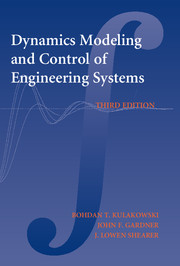Book contents
- Frontmatter
- Contents
- Preface
- Dynamic Modeling and Control of Engineering Systems
- 1 INTRODUCTION
- 2 MECHANICAL SYSTEMS
- 3 MATHEMATICAL MODELS
- 4 ANALYTICAL SOLUTIONS OF SYSTEM INPUT–OUTPUT EQUATIONS
- 5 NUMERICAL SOLUTIONS OF ORDINARY DIFFERENTIAL EQUATIONS
- 6 SIMULATION OF DYNAMIC SYSTEMS
- 7 ELECTRICAL SYSTEMS
- 8 THERMAL SYSTEMS
- 9 FLUID SYSTEMS
- 10 MIXED SYSTEMS
- 11 SYSTEM TRANSFER FUNCTIONS
- 12 FREQUENCY ANALYSIS
- 13 CLOSED-LOOP SYSTEMS AND SYSTEM STABILITY
- 14 CONTROL SYSTEMS
- 15 ANALYSIS OF DISCRETE-TIME SYSTEMS
- 16 DIGITAL CONTROL SYSTEMS
- APPENDIX 1 Fourier Series and the Fourier Transform
- APPENDIX 2 Laplace Transforms
- APPENDIX 3 MATLAB Tutorial
- APPENDIX 4 Simulink Tutorial
- Index
13 - CLOSED-LOOP SYSTEMS AND SYSTEM STABILITY
Published online by Cambridge University Press: 05 June 2012
- Frontmatter
- Contents
- Preface
- Dynamic Modeling and Control of Engineering Systems
- 1 INTRODUCTION
- 2 MECHANICAL SYSTEMS
- 3 MATHEMATICAL MODELS
- 4 ANALYTICAL SOLUTIONS OF SYSTEM INPUT–OUTPUT EQUATIONS
- 5 NUMERICAL SOLUTIONS OF ORDINARY DIFFERENTIAL EQUATIONS
- 6 SIMULATION OF DYNAMIC SYSTEMS
- 7 ELECTRICAL SYSTEMS
- 8 THERMAL SYSTEMS
- 9 FLUID SYSTEMS
- 10 MIXED SYSTEMS
- 11 SYSTEM TRANSFER FUNCTIONS
- 12 FREQUENCY ANALYSIS
- 13 CLOSED-LOOP SYSTEMS AND SYSTEM STABILITY
- 14 CONTROL SYSTEMS
- 15 ANALYSIS OF DISCRETE-TIME SYSTEMS
- 16 DIGITAL CONTROL SYSTEMS
- APPENDIX 1 Fourier Series and the Fourier Transform
- APPENDIX 2 Laplace Transforms
- APPENDIX 3 MATLAB Tutorial
- APPENDIX 4 Simulink Tutorial
- Index
Summary
LEARNING OBJECTIVES FOR THIS CHAPTER
13–1 To understand the concept of system stability and its implication for dynamic feedback systems.
13–2 To apply algebraic stability criteria for linear dynamic models.
13–3 To apply frequency-domain stability criteria for linear dynamic models.
13–4 To assess relative stability of linear dynamic systems by using phase margin and gain margin.
13–5 To plot and interpret the root locus of linear dynamic systems.
INTRODUCTION
Up to this point, the modeling and analysis in this text have dealt mainly with systems resulting from the straightforward interconnection of A-type, T-type, and D-type elements together with energy-converting transducers. The graphical representation of these system models by use of simulation block diagrams has revealed the widespread natural occurrence of closed loops containing one or more integrators, each loop of which involves feedback to a summing point. The techniques of analysis used so far with these passive systems have led to descriptions of their dynamic characteristics by means of sets of state-variable equations and/or input–output differential equations and transfer functions. These systems are considered passive because no attempts have been made intentionally to close additional loops with signal-amplifying or signal-modifying devices. They are simply collections of naturally occurring phenomena that, to be naturally occurring, must be inherently stable in order to survive.
- Type
- Chapter
- Information
- Dynamic Modeling and Control of Engineering Systems , pp. 329 - 355Publisher: Cambridge University PressPrint publication year: 2007

